Deck 23: World War II: Fighting the Good War, 1939-1945
Question
Question
Question
Question
Question
Question
Question
Question
Question
Question
Question
Question
Question
Question
Question
Question
Question
Question
Question
Question
Question
Question
Question
Question
Question
Question
Question
Question
Question
Question
Question
Question
Question
Question
Question
Question
Question
Question
Question
Question
Question
Question
Question
Question
Question
Question
Question
Question

Unlock Deck
Sign up to unlock the cards in this deck!
Unlock Deck
Unlock Deck
1/48
Play
Full screen (f)
Deck 23: World War II: Fighting the Good War, 1939-1945
1
In which of the following were Japanese Americans treated most leniently during World War II?
A) Washington
B) Oregon
C) California
D) Hawaii
A) Washington
B) Oregon
C) California
D) Hawaii
Hawaii
2
What was the most immediate result depicted in this photograph of the Japanese attack that took place at Pearl Harbor on December 7, 1941?
A) Non-interventionists in the United States insisted that the country not get involved in war.
B) Japan stopped its expansionist drive into East Asia.
C) The United States declared war on Japan the next day.
D) The U.S. government released such photographs immediately after the attack to arouse public anger against Japan.
A) Non-interventionists in the United States insisted that the country not get involved in war.
B) Japan stopped its expansionist drive into East Asia.
C) The United States declared war on Japan the next day.
D) The U.S. government released such photographs immediately after the attack to arouse public anger against Japan.
The United States declared war on Japan the next day.
3
Which of the following situations that took place during the 1930s was an example of appeasement by the Allies in Europe towards Germany?
A) Germany's invasion of Poland in 1939
B) permitting Germany to allow harsh anti-Semitic policies within its boundaries
C) allowing Germany to occupy the Sudetenland after the 1938 Munich Conference
D) the USSR's signing of a non-aggression pact with Germany in 1939
A) Germany's invasion of Poland in 1939
B) permitting Germany to allow harsh anti-Semitic policies within its boundaries
C) allowing Germany to occupy the Sudetenland after the 1938 Munich Conference
D) the USSR's signing of a non-aggression pact with Germany in 1939
allowing Germany to occupy the Sudetenland after the 1938 Munich Conference
4
As a result of Executive Order 9066 that President Roosevelt signed on February 19, 1942, the U.S. military .
A) confiscated or destroyed all belongings owned by people of Japanese ancestry
B) drafted all Nisei men into the army
C) declared the West Coast a military zone closed to all persons of Japanese ancestry
D) lifted the ban that had been placed earlier on Chinese immigration
A) confiscated or destroyed all belongings owned by people of Japanese ancestry
B) drafted all Nisei men into the army
C) declared the West Coast a military zone closed to all persons of Japanese ancestry
D) lifted the ban that had been placed earlier on Chinese immigration

Unlock Deck
Unlock for access to all 48 flashcards in this deck.
Unlock Deck
k this deck
5
What is most likely the reason why government officials censored this Dorothea Lange photograph of a Japanese-American reporting to an evacuation center?
A) The image of a person of Japanese descent in military uniform was considered to be troublesome.
B) His being a veteran undermined the notion that residents of Japanese descent were threats.
C) The man's evident distress was deemed to be too upsetting.
D) The government wanted to conceal the existence of the evacuation centers.
A) The image of a person of Japanese descent in military uniform was considered to be troublesome.
B) His being a veteran undermined the notion that residents of Japanese descent were threats.
C) The man's evident distress was deemed to be too upsetting.
D) The government wanted to conceal the existence of the evacuation centers.

Unlock Deck
Unlock for access to all 48 flashcards in this deck.
Unlock Deck
k this deck
6
Why did the United States pass the Neutrality Acts between 1935 and 1939?
A) to restrict arms sales, loans, and transport of good to nations at war
B) to urge peaceful nations to isolate aggressor nations and seek peace
C) to assure that the nations that fought Germany in World War I repay their loans
D) to require a national referendum for any declaration of war
A) to restrict arms sales, loans, and transport of good to nations at war
B) to urge peaceful nations to isolate aggressor nations and seek peace
C) to assure that the nations that fought Germany in World War I repay their loans
D) to require a national referendum for any declaration of war

Unlock Deck
Unlock for access to all 48 flashcards in this deck.
Unlock Deck
k this deck
7
What was the major characteristic of a fascist state, such as the one created in Germany when Adolf Hitler gained power in 1933?
A) the constant surveillance of a civilian population
B) the public ownership of property
C) the glorification of the state over the individual
D) any form of government that enforces conformity
A) the constant surveillance of a civilian population
B) the public ownership of property
C) the glorification of the state over the individual
D) any form of government that enforces conformity

Unlock Deck
Unlock for access to all 48 flashcards in this deck.
Unlock Deck
k this deck
8
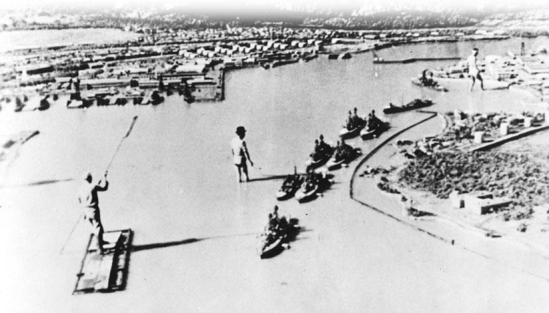
What major American weakness pictured in this mock-up of Pearl Harbor that was made for a Japanese wartime film led to the Japanese victory at this naval station?
A) The lined-up battleships were easy targets for aerial bombs.
B) The Japanese did not believe that the United States would unite in war against them.
C) America's two aircraft carriers were destroyed in this attack.
D) A Japanese air strike destroyed storage tanks containing millions of gallons of fuel oil.

Unlock Deck
Unlock for access to all 48 flashcards in this deck.
Unlock Deck
k this deck
9
What policy was President Roosevelt referring to when he described it as simply one neighbor helping another one put out a fire?
A) the Neutrality Act of 1939
B) Lend-Lease
C) "cash and carry"
D) non-intervention
A) the Neutrality Act of 1939
B) Lend-Lease
C) "cash and carry"
D) non-intervention

Unlock Deck
Unlock for access to all 48 flashcards in this deck.
Unlock Deck
k this deck
10

Why did Life magazine publish this photograph of a reporter with a note identifying him as Chinese instead of Japanese shortly after the start of U.S. involvement in World War II?
A) to instruct Americans in distinguishing between Asian enemies and allies
B) to encourage public violence against Asians and Asian Americans in the United States
C) to show that the Chinese were friendly but that Japanese-Americans supported imperial Japan
D) to promote greater immigration to the United States from China

Unlock Deck
Unlock for access to all 48 flashcards in this deck.
Unlock Deck
k this deck
11
How did President Roosevelt decide to deal with containing Japanese expansion in East Asia while dealing with rising tensions in Europe at the same time?
A) He bribed the Japanese by increasing the number of oil shipments to that nation.
B) He convinced the Soviet Union to intervene in Japanese-occupied Manchuria and China.
C) He had Congress issue a formal declaration of war against Japan.
D) He escalated economic sanctions and warnings on Japan so he that could focus on the war in Europe.
A) He bribed the Japanese by increasing the number of oil shipments to that nation.
B) He convinced the Soviet Union to intervene in Japanese-occupied Manchuria and China.
C) He had Congress issue a formal declaration of war against Japan.
D) He escalated economic sanctions and warnings on Japan so he that could focus on the war in Europe.

Unlock Deck
Unlock for access to all 48 flashcards in this deck.
Unlock Deck
k this deck
12
What did the skirmish between the American destroyer Greer and German submarines in September 1940 indicate about the American role in World War II prior to December 7, 1941?
A) The United States abandoned its Lend-Lease policy with Britain.
B) The United States declared war on Germany before it declared war on Japan.
C) The United States was already fighting Germany in an undeclared war in the Atlantic.
D) The United States formally abandoned neutrality in the European conflict at this time.
A) The United States abandoned its Lend-Lease policy with Britain.
B) The United States declared war on Germany before it declared war on Japan.
C) The United States was already fighting Germany in an undeclared war in the Atlantic.
D) The United States formally abandoned neutrality in the European conflict at this time.

Unlock Deck
Unlock for access to all 48 flashcards in this deck.
Unlock Deck
k this deck
13
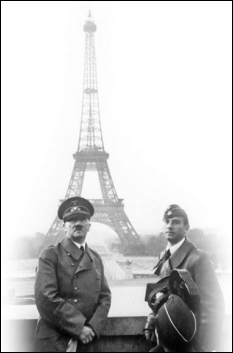
Why did Adolf Hitler choose to pose in front of the Eiffel Tower in this photograph taken in Paris after the fall of France in 1940?
A) He wanted to highlight France's defeat and his own power.
B) The tower symbolized the same industrial advancements that Germany had accomplished.
C) He was a great admirer of Parisian architecture.
D) He wanted to honor the tower's designer, who had been born in Germany.

Unlock Deck
Unlock for access to all 48 flashcards in this deck.
Unlock Deck
k this deck
14
What three nations signed the Tripartite Pact on September 27, 1940, and became the major Axis Powers during World War II?
A) Germany, Italy, France
B) the Soviet Union, Germany, Italy
C) Germany, Japan, Italy
D) the Soviet Union, Germany, Japan
A) Germany, Italy, France
B) the Soviet Union, Germany, Italy
C) Germany, Japan, Italy
D) the Soviet Union, Germany, Japan

Unlock Deck
Unlock for access to all 48 flashcards in this deck.
Unlock Deck
k this deck
15

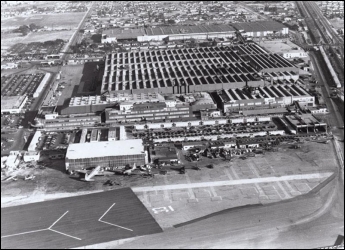

Defense factories on the West Coast, such as this aircraft factory in Burbank, California, camouflaged their facilities with painted tarps and cardboard houses because they .
A) were secretly developing plans for an atomic bomb
B) did not want the American public to know how much money was being spent on war production
C) wanted to keep their products and locations secret from potential Soviet spies
D) feared a Japanese attack in this region

Unlock Deck
Unlock for access to all 48 flashcards in this deck.
Unlock Deck
k this deck
16
How was the 1937 Neutrality Act different from other neutrality acts passed by the United States?
A) It allowed belligerent nations to purchase munitions and non-war-related goods.
B) It prohibited the sales of arms and ammunition to nations at war.
C) It loaned arms to nations at war with Germany.
D) It allowed belligerent nations to buy non-war-related goods and transport them on their own.
A) It allowed belligerent nations to purchase munitions and non-war-related goods.
B) It prohibited the sales of arms and ammunition to nations at war.
C) It loaned arms to nations at war with Germany.
D) It allowed belligerent nations to buy non-war-related goods and transport them on their own.

Unlock Deck
Unlock for access to all 48 flashcards in this deck.
Unlock Deck
k this deck
17
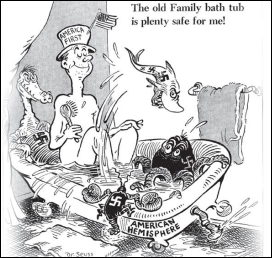
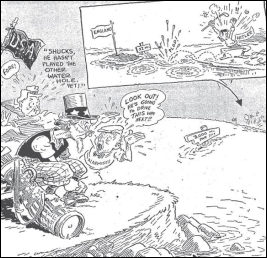
What two key messages do both the interventionist cartoon by Dr. Seuss on the left and the non-interventionist cartoon by the pro-Republican Chicago Tribune on the right relay to the public?
A) American support for the European Allies while remaining geographically isolated
B) a call for American neutrality and the imminent threat of a Japanese invasion
C) an urgent need for immediate U.S. involvement in Europe in addition to the building up of
U.S. naval power in the Atlantic
D) a false lull caused by geographic isolation as well as German aggression in Europe and the Atlantic

Unlock Deck
Unlock for access to all 48 flashcards in this deck.
Unlock Deck
k this deck
18

What conclusion can be made about the events leading to American involvement in World War II during the 1930s and early 1940s?
A) While Europe was experiencing turmoil during the 1930s, Asia was relatively peaceful.
B) The United States was concerned about conflicts in both Europe and Asia during the 1930s.
C) The United States actively supported Germany and Japan during the 1930s.
D) U.S. allies in Europe were at peace with Germany before the Japanese attack on Pearl Harbor.

Unlock Deck
Unlock for access to all 48 flashcards in this deck.
Unlock Deck
k this deck
19
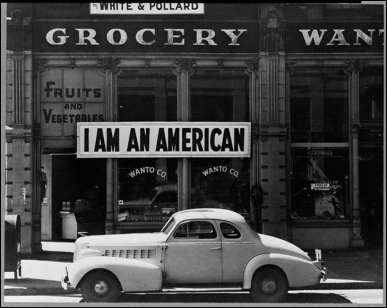
Why did the Japanese-American owner of this grocery store hang a poster that declared his nationality the day after the attack on Pearl Harbor?
A) He wanted to encourage further immigration to the United States from Japan.
B) He wanted to announce his enlistment in the U.S. Army to fight against Japan.
C) He wanted to bolster American support for confining those of Japanese origin to internment camps.
D) He wanted to fight back against the perception that he was a traitor to the United States.

Unlock Deck
Unlock for access to all 48 flashcards in this deck.
Unlock Deck
k this deck
20
What did war correspondent Ernie Pyle imply when he stated that "In Europe, we felt that our enemies, horrible and deadly as they were, were still people, but out here [in the Pacific Theater] I soon gathered that the Japanese were looked upon…the way some people feel about cockroaches and mice"?
A) German belligerents were considered to be more inhumane than the Japanese.
B) Americans viewed the Japanese as subhuman and repulsive when compared to the Germans.
C) German and Japanese soldiers were equally seen as being evil enemies.
D) Americans felt that the Japanese were weaker and more humane than their German enemies.
A) German belligerents were considered to be more inhumane than the Japanese.
B) Americans viewed the Japanese as subhuman and repulsive when compared to the Germans.
C) German and Japanese soldiers were equally seen as being evil enemies.
D) Americans felt that the Japanese were weaker and more humane than their German enemies.

Unlock Deck
Unlock for access to all 48 flashcards in this deck.
Unlock Deck
k this deck
21
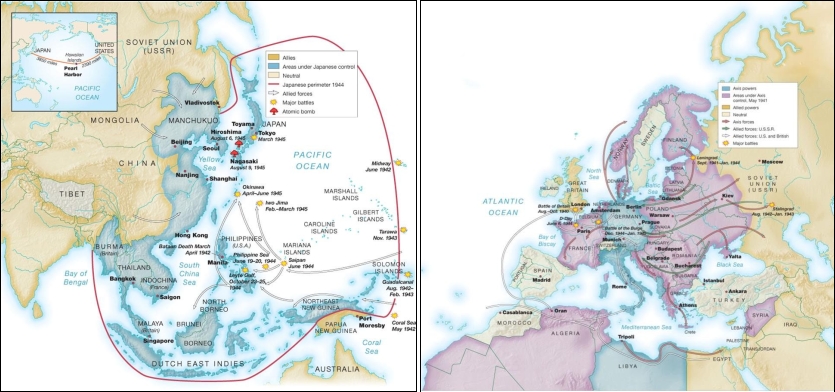
Based on these maps, one common feature in the Allied military strategy in both the Pacific and European theaters of war was to .
A) detonate atomic weapons in both Germany and Japan
B) initially attack Germany and Japan through the "soft underbellies" of their empires
C) use an extensive island-hopping strategy in the Pacific and Mediterranean
D) rely on numerous Allied military bases in Europe and the Pacific to launch attacks

Unlock Deck
Unlock for access to all 48 flashcards in this deck.
Unlock Deck
k this deck
22
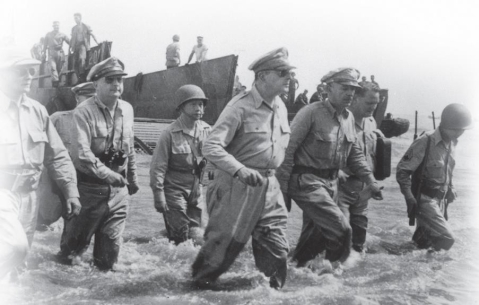
What was General MacArthur's primary purpose in inviting the press to photograph him in this carefully choreographed act after his return to the Philippines in 1944?
A) to instill pride and confidence in the troops
B) to encourage U.S. leadership to abandon its "Europe First" strategy
C) to intimidate his Japanese enemies
D) to satisfy his own ego

Unlock Deck
Unlock for access to all 48 flashcards in this deck.
Unlock Deck
k this deck
23
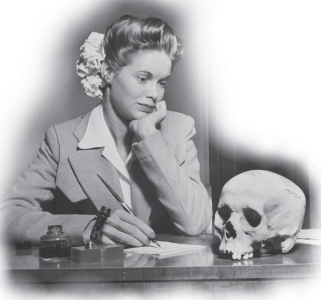
What generalization can be made from the 1944 Life magazine photograph "A Wartime Souvenir," in which a young American woman writes her fiancé a thank-you note for sending her a Japanese soldier's skull?
A) American soldiers collected both Japanese and German body parts as trophies.
B) American soldiers sent memento mori to loved ones to remind them of the danger they faced.
C) Collecting enemy Japanese body parts was common because they were considered subhuman.
D) Many American civilians wrote and reflected on the high death casualties from this war.

Unlock Deck
Unlock for access to all 48 flashcards in this deck.
Unlock Deck
k this deck
24
Which combination of factors significantly contributed to the Allied victory in World War II?
A) the early efforts of the United States and its rapid establishment of superior naval power in the Atlantic
B) the military preparedness and clear moral superiority of the Allies
C) the Allies' greater technological advancement and well-seasoned troops
D) the economic capacity of the Allies and their ability to sustain their effort on multiple fronts
A) the early efforts of the United States and its rapid establishment of superior naval power in the Atlantic
B) the military preparedness and clear moral superiority of the Allies
C) the Allies' greater technological advancement and well-seasoned troops
D) the economic capacity of the Allies and their ability to sustain their effort on multiple fronts

Unlock Deck
Unlock for access to all 48 flashcards in this deck.
Unlock Deck
k this deck
25
Japan went permanently on the defensive after its defeat at the Battle of .
A) Iwo Jima
B) the Philippine Sea
C) the Coral Sea
D) Midway
A) Iwo Jima
B) the Philippine Sea
C) the Coral Sea
D) Midway

Unlock Deck
Unlock for access to all 48 flashcards in this deck.
Unlock Deck
k this deck
26
Of the Native Americans who served in World War II, the Navajos were particularly noted for .
A) their infiltration of the Japanese army to provide invaluable intelligence
B) their valiance in the South Pacific
C) breaking the German naval code
D) transmitting secret codes in their native language, which could not be broken by the Japanese
A) their infiltration of the Japanese army to provide invaluable intelligence
B) their valiance in the South Pacific
C) breaking the German naval code
D) transmitting secret codes in their native language, which could not be broken by the Japanese

Unlock Deck
Unlock for access to all 48 flashcards in this deck.
Unlock Deck
k this deck
27
The recruiting slogan "Release a man for combat" for the Women's Auxiliary Corps (WACs) signifies that _.
A) most WACs were assigned to defense companies where they worked as riveters
B) women faced different and often less-dangerous risks than men in the military
C) both men and women in the American military actively participated in combat
D) women in the military were usually relegated to office jobs and other positions traditionally held by females
A) most WACs were assigned to defense companies where they worked as riveters
B) women faced different and often less-dangerous risks than men in the military
C) both men and women in the American military actively participated in combat
D) women in the military were usually relegated to office jobs and other positions traditionally held by females

Unlock Deck
Unlock for access to all 48 flashcards in this deck.
Unlock Deck
k this deck
28
American involvement in World War II fostered a general intolerance for nonconformity that included the wearing of zoot-suits because .
A) Americans desired unity against their enemies
B) domestic conflicts paled in comparison to foreign conflicts
C) the government suppressed any opposition to the war
D) nonconformists were viewed as agents of the enemy
A) Americans desired unity against their enemies
B) domestic conflicts paled in comparison to foreign conflicts
C) the government suppressed any opposition to the war
D) nonconformists were viewed as agents of the enemy

Unlock Deck
Unlock for access to all 48 flashcards in this deck.
Unlock Deck
k this deck
29
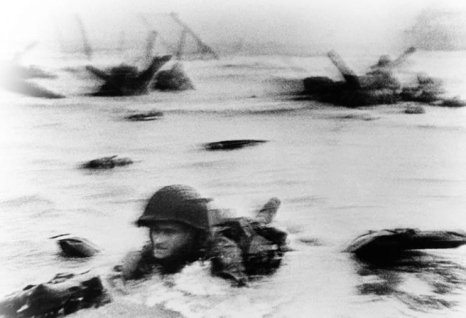
Although Life magazine photographer Robert Capa's images of the 1944 D-Day invasion accidentally came out blurred after a darkroom technician used too much heat to dry the film, this grainy image became iconic because it .
A) captured the chaos and danger faced by American soldiers on the beaches of Normandy
B) showed how easy the victory at Normandy was for Allied troops
C) depicted the ineffective German strategy of defending its beachhead in Normandy
D) revealed that the Normandy invasion was a diversion from a bigger invasion further north

Unlock Deck
Unlock for access to all 48 flashcards in this deck.
Unlock Deck
k this deck
30
African Americans fighting in the Pacific theater stated that the most fitting epitaph for a black soldier was "here lies a black man killed fighting a yellow man for the protection of a white man." Which of the following best supports this statement?
A) African American soldiers suffered a higher mortality rate than other racial groups.
B) Many wartime industries refused to hire African Americans.
C) African Americans fought for their nation but still faced discrimination.
D) World War II German prisoners of war received better treatment than African American soldiers.
A) African American soldiers suffered a higher mortality rate than other racial groups.
B) Many wartime industries refused to hire African Americans.
C) African Americans fought for their nation but still faced discrimination.
D) World War II German prisoners of war received better treatment than African American soldiers.

Unlock Deck
Unlock for access to all 48 flashcards in this deck.
Unlock Deck
k this deck
31
General Dwight D. Eisenhower commanded the .
A) bombing raids on German cities
B) Battle of the Atlantic
C) North African campaign
D) invasion of Normandy
A) bombing raids on German cities
B) Battle of the Atlantic
C) North African campaign
D) invasion of Normandy

Unlock Deck
Unlock for access to all 48 flashcards in this deck.
Unlock Deck
k this deck
32
What common public misconception about "Rosie the Riveter" developed as a result of the Norman Rockwell Saturday Evening Post cover and J. Howard Miller's "We Can Do It" poster?
A) Both the Rockwell cover and the Miller poster show their subjects wearing wedding rings, meaning that most women in the war work force were married instead of single.
B) Neither image addresses the domestic role women played, including food production at home.
C) The Rockwell cover actually portrays a true riveter in a defense job, while the Miller poster shows a Westinghouse Electric employee whose purpose was to promote company unity.
D) The Rockwell cover portrays a mannish-looking woman without makeup, while the Miller poster shows a prim young lady with makeup, something not possible during World War II.
A) Both the Rockwell cover and the Miller poster show their subjects wearing wedding rings, meaning that most women in the war work force were married instead of single.
B) Neither image addresses the domestic role women played, including food production at home.
C) The Rockwell cover actually portrays a true riveter in a defense job, while the Miller poster shows a Westinghouse Electric employee whose purpose was to promote company unity.
D) The Rockwell cover portrays a mannish-looking woman without makeup, while the Miller poster shows a prim young lady with makeup, something not possible during World War II.

Unlock Deck
Unlock for access to all 48 flashcards in this deck.
Unlock Deck
k this deck
33
What was the double-victory campaign that was promoted in the United States during the war?
A) the efforts against fascism in Europe and racism at home
B) the efforts in the European and Pacific theaters
C) the efforts in the two major fronts of the European theater
D) the efforts against segregation both in the military and at home
A) the efforts against fascism in Europe and racism at home
B) the efforts in the European and Pacific theaters
C) the efforts in the two major fronts of the European theater
D) the efforts against segregation both in the military and at home

Unlock Deck
Unlock for access to all 48 flashcards in this deck.
Unlock Deck
k this deck
34
What was one factor that made World War II particularly beneficial for the American economy?
A) There was sharp drop in the price of manufactured goods in the United States.
B) The government was able to pay off its war debts before 1950.
C) The American home front had an excess of food products that led to splurging.
D) Massive government spending on the war brought an end to the Great Depression.
A) There was sharp drop in the price of manufactured goods in the United States.
B) The government was able to pay off its war debts before 1950.
C) The American home front had an excess of food products that led to splurging.
D) Massive government spending on the war brought an end to the Great Depression.

Unlock Deck
Unlock for access to all 48 flashcards in this deck.
Unlock Deck
k this deck
35
In 1941, African American leader A. Philip Randolph planned to protest .
A) American involvement in the war
B) segregation in the military
C) discrimination by employers
D) the rise in racial riots across the nation
A) American involvement in the war
B) segregation in the military
C) discrimination by employers
D) the rise in racial riots across the nation

Unlock Deck
Unlock for access to all 48 flashcards in this deck.
Unlock Deck
k this deck
36
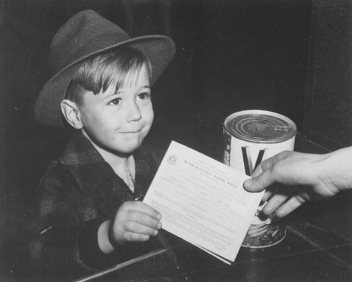
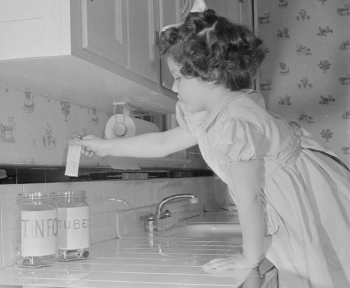
These two photographs depicting American children shopping with ration books and collecting metal for local scrap drives during World War II reveal that .
A) scarcity impacted many American families
B) overproduction led to more expensive goods in markets
C) propaganda had little impact on American children
D) children played a marginal patriotic role on the home front

Unlock Deck
Unlock for access to all 48 flashcards in this deck.
Unlock Deck
k this deck
37
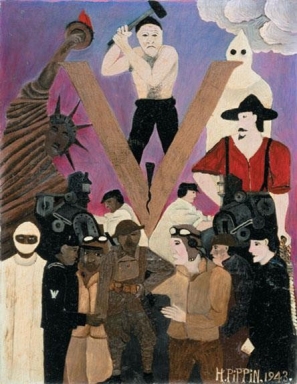
In his 1943 painting Mr. Prejudice, African American painter Horace Pippin shows that
A) the dream of racial unity was close to becoming a reality after a victory against the Axis forces in World War II
B) racial discord on the home front jeopardized the African American vision of using the war to secure democracy at home and abroad
C) desegregation took place in all branches of the military at the end of World War II
D) a united front of blacks and whites were prepared to take on racist perpetrators that included the Ku Klux Klan and lynch mobs

Unlock Deck
Unlock for access to all 48 flashcards in this deck.
Unlock Deck
k this deck
38
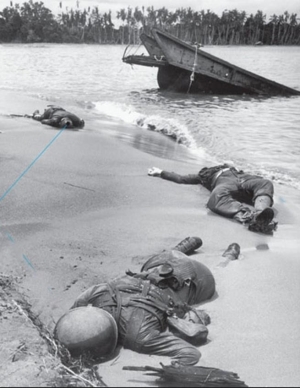
Why did the War Department in 1943 approve the dissemination of bloody battlefield photographs such as Life magazine's "Here Lie Three Americans," although victories in the South Pacific and North Africa had raised spirits at home?
A) The War Department felt that morbid pictures like this one would decrease morale at home.
B) The American public needed to be reminded that continued civilian sacrifice was still needed.
C) Life magazine believed it could sell more issues if it focused on shocking images from the war.
D) The War Department was hoping that the public could help identify the bodies of unknown soldiers.

Unlock Deck
Unlock for access to all 48 flashcards in this deck.
Unlock Deck
k this deck
39
During World War II, why were many American mainstream newspapers initially reluctant to publish articles about the Holocaust in Europe?
A) They were hesitant to print potentially false atrocity stories amid a glut of war news.
B) They were not sympathetic to the horrors facing Europe's Jewish population.
C) They felt that this situation was already significantly covered by European newspapers.
D) They believed that the images and stories were too shocking for the American public.
A) They were hesitant to print potentially false atrocity stories amid a glut of war news.
B) They were not sympathetic to the horrors facing Europe's Jewish population.
C) They felt that this situation was already significantly covered by European newspapers.
D) They believed that the images and stories were too shocking for the American public.

Unlock Deck
Unlock for access to all 48 flashcards in this deck.
Unlock Deck
k this deck
40
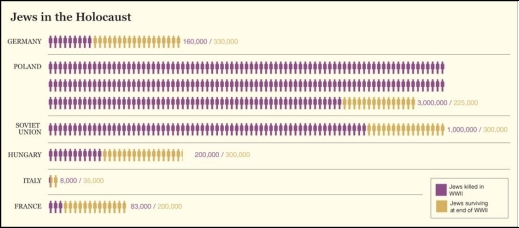
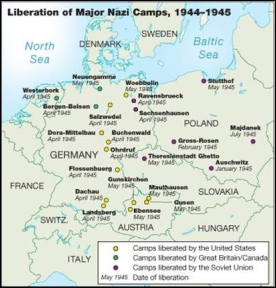
What conclusion can be reached about the Holocaust based on this graph and map?
A) More German Jews died during the Holocaust than did those from other European nations.
B) Most Jews survived the concentration camps rather than dying there.
C) Although most concentration camps were in Germany, most of the Jews who died in the Holocaust came from Eastern Europe.
D) Adolf Hitler was successful in completely eliminating Europe's Jewish population.

Unlock Deck
Unlock for access to all 48 flashcards in this deck.
Unlock Deck
k this deck
41
The U.S. bombing campaign in the Pacific theater differed from that against Germany in that the United States .
A) quickly abandoned the strategy as ineffective against Japan
B) bombed very few urban centers in Japan
C) did not distinguish between military and civilian targets in Japan
D) lost an astonishing number of pilots while fighting Japan
A) quickly abandoned the strategy as ineffective against Japan
B) bombed very few urban centers in Japan
C) did not distinguish between military and civilian targets in Japan
D) lost an astonishing number of pilots while fighting Japan

Unlock Deck
Unlock for access to all 48 flashcards in this deck.
Unlock Deck
k this deck
42
The main reason behind President Truman's decision to drop the atomic bomb was that
A) he was xenophobic and particularly disliked the Japanese
B) U.S. intelligence knew that Japan was close to developing its own atomic bomb
C) Stalin was urging the United States to use the weapon to conclude the war
D) he hoped to end the war as quickly as possible and thus save American lives
A) he was xenophobic and particularly disliked the Japanese
B) U.S. intelligence knew that Japan was close to developing its own atomic bomb
C) Stalin was urging the United States to use the weapon to conclude the war
D) he hoped to end the war as quickly as possible and thus save American lives

Unlock Deck
Unlock for access to all 48 flashcards in this deck.
Unlock Deck
k this deck
43
After becoming president after Roosevelt's death in 1945, former Vice President Harry Truman knew nothing about the .
A) Manhattan Project
B) plans for the D-Day invasion
C) state of Roosevelt's health
D) bombing of civilians in Japan
A) Manhattan Project
B) plans for the D-Day invasion
C) state of Roosevelt's health
D) bombing of civilians in Japan

Unlock Deck
Unlock for access to all 48 flashcards in this deck.
Unlock Deck
k this deck
44
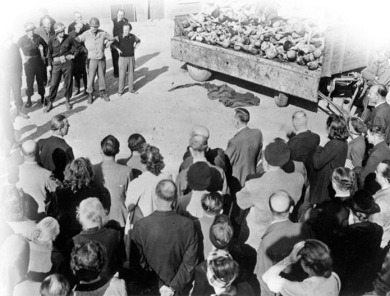
Why did American forces make German citizens view and even bury the bodies of Holocaust victims, such as they did with these people at the recently-liberated Buchenwald concentration camp?
A) to acknowledge that the Allies were the liberators of these concentration camps
B) to thank these Germans for their efforts in trying to save Jews and other victims
C) to prepare them for their own executions for violations of human rights
D) to make all Germans accept responsibility for their nation's war crimes

Unlock Deck
Unlock for access to all 48 flashcards in this deck.
Unlock Deck
k this deck
45
Why did the United States choose the Japanese cities of Hiroshima and Nagasaki as the sites for the dropping of two atomic bombs?
A) Both cities were of significant military value to the Japanese.
B) Both cities had been spared from earlier firebombing and presented virgin grounds that would show the full impact of each bomb.
C) Both cities had resisted earlier attempts by American troops to seize them by land.
D) Both cities were major cultural and political centers for the Japanese.
A) Both cities were of significant military value to the Japanese.
B) Both cities had been spared from earlier firebombing and presented virgin grounds that would show the full impact of each bomb.
C) Both cities had resisted earlier attempts by American troops to seize them by land.
D) Both cities were major cultural and political centers for the Japanese.

Unlock Deck
Unlock for access to all 48 flashcards in this deck.
Unlock Deck
k this deck
46
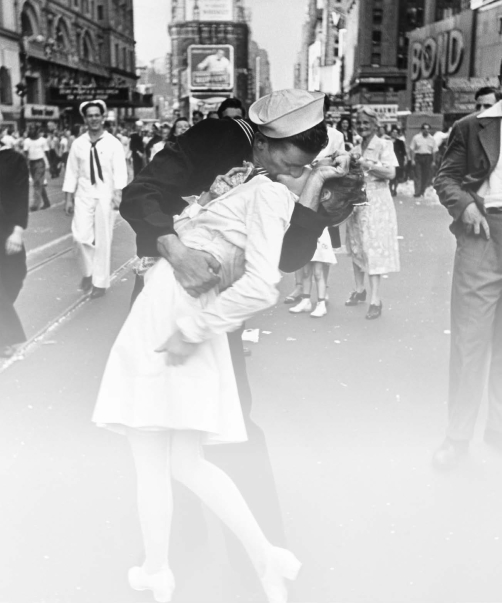
Why did the Alfred Eisenstaedt photograph "Kiss in Times Square" become an iconic image of World War II?
A) Some see this kiss as an affirmation of life and hopefulness.
B) The photograph appropriately honored the service of the American Navy and war nurses.
C) American morals had become more relaxed as a result of World War II.
D) The kiss was a symbol of the global reunification and harmony that took place after the war.

Unlock Deck
Unlock for access to all 48 flashcards in this deck.
Unlock Deck
k this deck
47
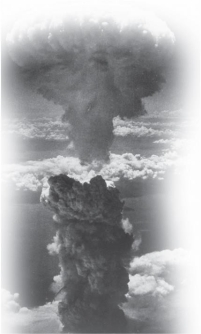
Images such as this one of the atomic bomb that destroyed much of Nagasaki attest to the
A) sound reasoning behind President Truman's decision to drop the bomb
B) courage of those who developed the atomic bomb
C) psychological impact of the atomic bomb
D) carelessness of the Americans in using the atomic bomb

Unlock Deck
Unlock for access to all 48 flashcards in this deck.
Unlock Deck
k this deck
48
As a result of the Battles of Iwo Jima and Okinawa, the United States _ .
A) was confident that the war in the Pacific would soon come to an end
B) eagerly awaited the Soviets' imminent declaration of war on Japan
C) anticipated a long and bloody invasion of the Japanese mainland
D) was ill-prepared to continue the war against Japan
A) was confident that the war in the Pacific would soon come to an end
B) eagerly awaited the Soviets' imminent declaration of war on Japan
C) anticipated a long and bloody invasion of the Japanese mainland
D) was ill-prepared to continue the war against Japan

Unlock Deck
Unlock for access to all 48 flashcards in this deck.
Unlock Deck
k this deck



